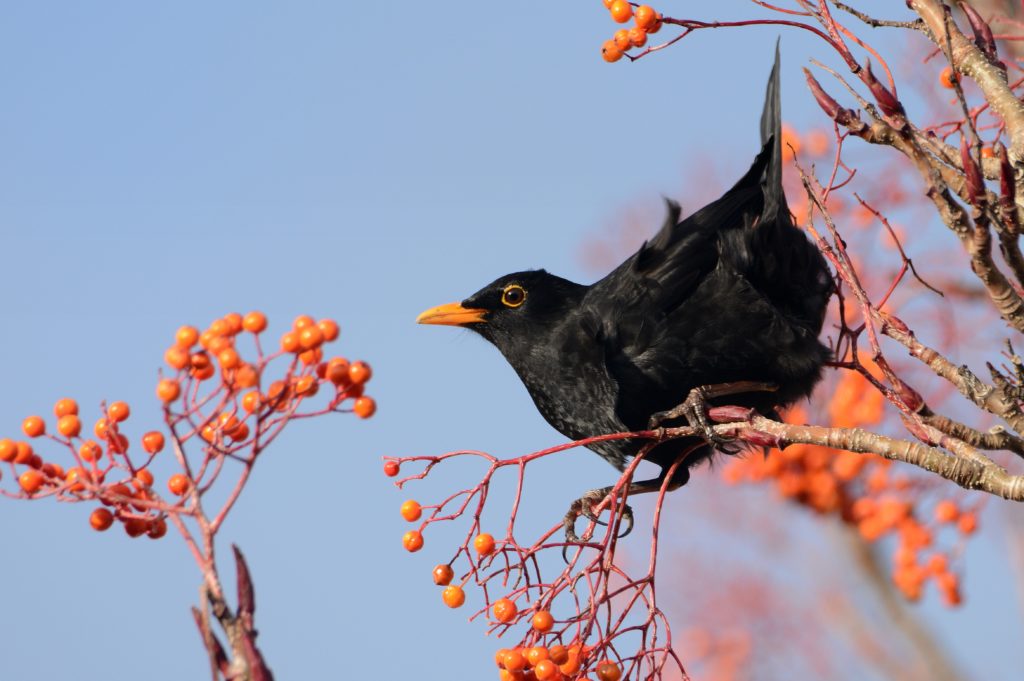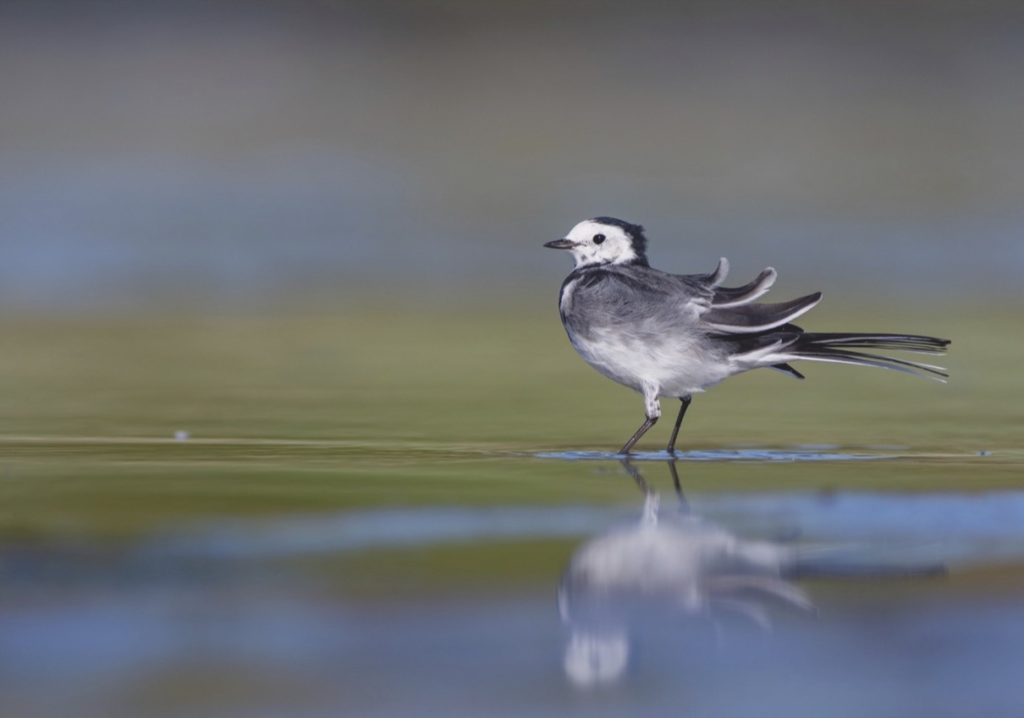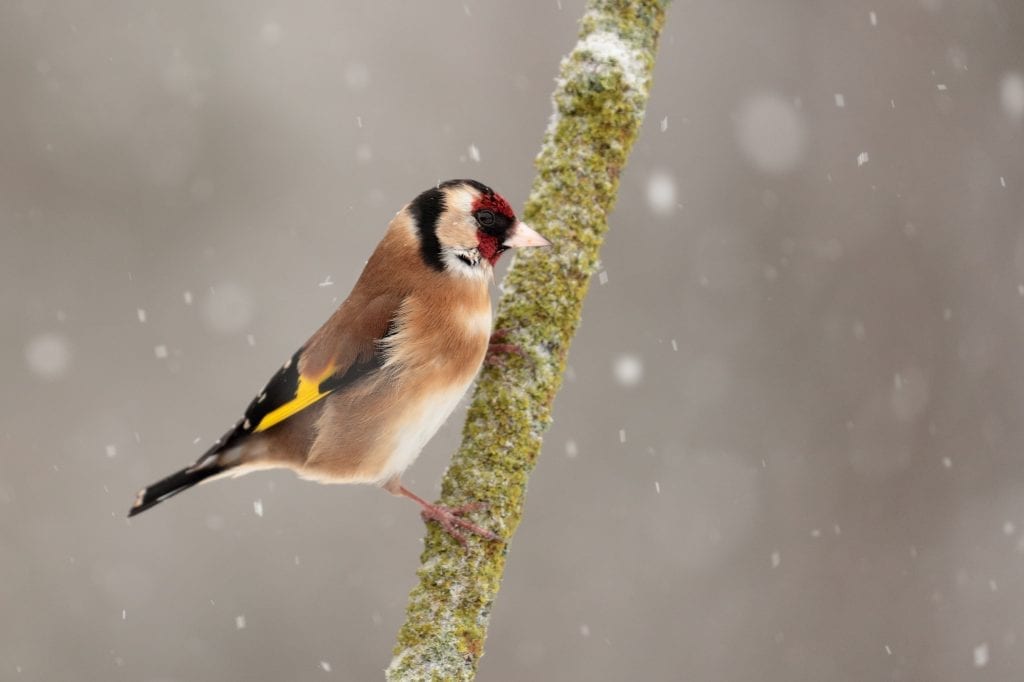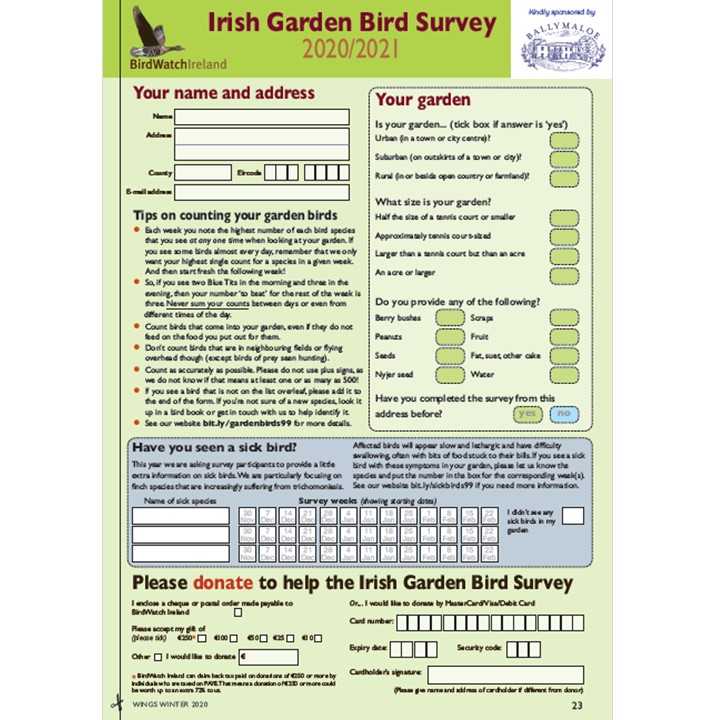
Collared Dove
| Irish Name: | Fearán baicdhubh |
| Scientific name: | Streptopelia decaocto |
| Bird Family: | Pigeons & Doves |
green
Conservation status
Conservation status
Status
Resident in towns and villages throughout Ireland. One of Ireland's top 20 most widespread garden birds.
Identification
A medium sized dove. Best identified from its narrow black, white edged, bar across the side of its neck. A rather uniformly coloured pale grey bird with dark outer wing feathers.
Voice
Trisyllabic coo, repeated several times.
Diet
Cereal grain, seeds and fruits of herbs and grasses, sometimes green parts and invertebrates.
Breeding
A recent colonist, it arrived in Ireland in 1959, after a rapid expansion through Europe in the preceding decades. It is now a widespread bird in Ireland but it shows a marked preference for suburbs, small towns and cereal growing areas. In the wider countryside it is only found in lowland areas and often in the vicinity of farm buildings, tends to avoid open countryside. Breeds in the dense foliage of trees. Nest a small flimsy flat platform of fine twigs. Usually two eggs.
Wintering
Similar to breeding distribution.
Monitored by
Blog posts about this bird

'Last Christmas' - Birds in Irish Gardens last winter
There's still time to take part in the Irish Garden Bird Survey!! See here for more details.
 If you’re a BirdWatch Ireland member you’ll have already read the results of last year’s survey in your winter edition of Wings magazine. If you’re not a member, please join and support our work! But you can catch up on last year’s Irish Garden Bird Survey results with the overview below. If this is your first year to take part in the survey, don’t worry about knowing every single species that might appear in your garden – just familiarise yourself with the most common ones to start off. If you’re a survey veteran, then see how your garden bird list compares to the national average!
If you’re a BirdWatch Ireland member you’ll have already read the results of last year’s survey in your winter edition of Wings magazine. If you’re not a member, please join and support our work! But you can catch up on last year’s Irish Garden Bird Survey results with the overview below. If this is your first year to take part in the survey, don’t worry about knowing every single species that might appear in your garden – just familiarise yourself with the most common ones to start off. If you’re a survey veteran, then see how your garden bird list compares to the national average!

Over 90% of Irish Gardens
The species at the top of the list didn’t change much from previous years. Robin, as per usual, was on top, followed by Blackbird and Blue Tit. Great Tit and Magpie moved up a place each into 4th and 5th, thanks to a fall in the numbers of Chaffinch reported. Robins can still be territorial in the winter, so are pretty evenly spread across the country, while our Blackbird population is topped up by hundreds of thousands of migrants from Scandinavia in the winter, hence their high-ranking each year. Blue Tits and Great Tits are pretty ubiquitous too, and Magpies are very effective at exploiting both urban and rural habitats.
80-90% of Irish Gardens
Chaffinch and Goldfinch fell two and three places to 6th and 10th respectively, since the previous winter, and those declines were greatest in urban and suburban gardens rather than rural ones. On the back of a great breeding season, Coal Tit moved up three places to 7th place. House Sparrows kept 8th position, and Starling made it into the top 10 garden birds for the first time in a decade!
50-80% of Irish Gardens
Wren dropped two places to 11th, while species such as Dunnock (12th), Rook (16th), Collared Dove (17th) all stayed in the same position as the previous winter. When a winter is pretty mild (the occasional storm excluded) we tend to see this stability in the rankings across many species. There was some slight movement for Woodpigeon (14th), Jackdaw (15th) and Hooded Crow (19th), all of which fell one place. The mild weather tends to mean these species aren’t forced to retreat to gardens for food as much as in other winters. Song Thrush increased by around 2% and jumped to places in the rankings to 13th. Pied Wagtail rose up two places to 18th and occurred in >7% more gardens than they did on average over the preceding five year period. Despite being very common in towns, cities and shopping centre carparks, they’re actually seen in twice as many rural gardens as urban or suburban ones. Greenfinch continue to suffer the devastating effects of trichomoniasis (make sure to clean your feeders regularly!) and reached a new low for the species in the survey – 20th place.
20-50% of Irish Gardens
While the above species occur in more than 50% of gardens, you’re in the minority if one of the below appears in your garden this winter: Siskin jumped up 7 places (8%) since the previous year. They usually start to appear in gardens from mid-January onwards, but they were making appearances from late November right through to March in most parts of the country last winter. No other species made such a big jump pup the table! One of the bigger losers was Goldcrest - down 5 places to 29th, a decrease of nearly 8%. It was a mild winter, and a good breeding season for most species in 2020, so the reason for this isn’t immediately obvious. Bullfinch dropped three places to 24th, but this might just be due to the mild winter and abundance of feeding options in the wider countryside, as they’re not a bird that visits feeders and so aren’t as associated with gardens as other finches. Other species in the 20-50% band include Blackcap, Long-tailed Tit, Sparrowhawk, Mistle Thrush and Feral Pigeon. Again, not species that tend to avail of bird feeders with any regularity, but species who know how to make a good living in a human-dominated landscape, be it rural, urban or suburban.Best of the rest
Despite being a non-native species, Pheasants tend to be seen in 15-20% of gardens each year, which is surprisingly high considering they don’t tend to breed well in the wild, so are reliant on being released by gun clubs every autumn. Buzzards moved two places up the rankings and are seen over 15% of gardens each winter. Herring Gulls were in 11% of gardens, Black-headed Gulls in 4%, and 1.3% of gardens had some sort of gull visiting but weren’t sure what species! Great Spotted Woodpeckers are one of the most recent additions to our bird community, and over 4% of gardens had one visiting their peanut feeders (it’s always peanut feeders!) last winter. They’re now breeding in almost every county in Ireland, so expect to see them charging up the rankings table in the coming years. Last year was a mast year for acorns, which meant Oak trees were providing a huge bounty for species such as Jays, and as a result they were seen in fewer gardens than usual (8%, down 1% from the average). This tends to happen every few years. Lastly, Redwing and Fieldfare, our two wintering thrush species, both dropped a bit, thanks again to the mild winter.
 See below for the full Top 30 birds in Irish gardens last winter, and their various ups and downs since the previous year. Most gardens record between 10 and 25 species over the course of a winter. Whether you have more or less than that, we still need you do to the survey!
See below for the full Top 30 birds in Irish gardens last winter, and their various ups and downs since the previous year. Most gardens record between 10 and 25 species over the course of a winter. Whether you have more or less than that, we still need you do to the survey!




We are hugely grateful to Ballymaloe for their sponsorship and support of the Irish Garden Bird Survey.
For more details about the Irish Garden Bird Survey click here, or download the survey form below.


Irish Garden Birds 2020 - How much do your garden birds weigh?
There's still time to get started with the Irish Garden Bird Survey! It's the biggest and longest-running survey of it's kind in Ireland. We need as many people as possible all over the country to take part this winter. Taking part couldn't be easier - See here for details on how to participate this winter . See below for information on how much your garden birds weigh, and why feeding them at this time of year is so important!
The Irish Garden Bird Survey is kindly sponsored by Ballymaloe. Click below to learn about taking part this winter.
 Traditionally, one might compare the weight of a small bird to that of a coin or a known amount of coins but given the likelihood that your wallet or purse has more plastic cards than coins in it, lets go with that. So, the average bank or supermarket clubcard weighs 5g – keep that in mind!
Traditionally, one might compare the weight of a small bird to that of a coin or a known amount of coins but given the likelihood that your wallet or purse has more plastic cards than coins in it, lets go with that. So, the average bank or supermarket clubcard weighs 5g – keep that in mind!
Less than 10 grams (two bank cards)
The smallest bird in Ireland is the Goldcrest – they weigh a mere 6g on average but can range from 4.7g (i.e. less than your bank card!) to 6.1g. Not far behind them, with average weights of 9-10g are Long-tailed Tit, Coal Tit, Treecreeper and Wren. These species will be the most active in your garden over the winter because the days are so short that they literally need to be feeding non-stop throughout the day to maintain their weight and survive the night! Wrens and Long-tailed Tits, amongst others, are known to communally roost during the winter – that is, they find some sheltered location and squeeze in together for the night in an effort to share body heat! In the case of Long-tailed Tits, because they’re all closely related they will take turns in the middle (i.e. warmest part) of the group before moving to the outside to give someone else a turn. For other species, where a roost will comprise of a number of unrelated individuals, they’re less generous, so you don’t want to be the last one in and stuck on the outside of the group!
Wrens and Long-tailed Tits, amongst others, are known to communally roost during the winter – that is, they find some sheltered location and squeeze in together for the night in an effort to share body heat! In the case of Long-tailed Tits, because they’re all closely related they will take turns in the middle (i.e. warmest part) of the group before moving to the outside to give someone else a turn. For other species, where a roost will comprise of a number of unrelated individuals, they’re less generous, so you don’t want to be the last one in and stuck on the outside of the group!
10-20g (two to four bank cards)
Some individual Blue Tits and Lesser Redpolls might come in at under 10g, but generally they average around 11g and can range up to 12.5g on a good day! Siskins are only slightly bigger at 13g, and then you have Goldfinch (17g), Great Tit (18g) and Robin (19g). Robins play it smart by staying territorial in the winter, and even the females will guard a territory – sometimes one where there’s suitable food but a lack of nesting space so it wouldn’t have been a core territory during the summer. By identifying somewhere with a suitable food source and aggressively guarding it, they save themselves a lot of energy and trouble having to range far and wide in search of food. Goldfinches do the opposite by flocking, but the more eyes in a flock the more likely you are to find food.20-30g (four to 6 bank cards, or 3 or 4 € coins)
Despite looking much chunkier and heavier, Bullfinches weigh the same on average as the slimline Pied Wagtail (both 21g), and our wintering Blackcaps are the same. Chaffinch weigh in at 24g on average, and it won’t surprise you that House Sparrow (27g) and Greenfinch (28g) are at the top end of the scale when it comes to ‘small’ garden birds. Still, as heavy as they might be, you’re still talking a few bank cards, or four €1 coins! When you think about the battle for survival that these birds face day in day out, it’s amazing that something so small and slight can achieve so much! Don't forget, in the case of the Chaffinch some of the birds in your garden will have migrated from as far away as Scandinavia, in the hope that their chances of finding food and surviving the winter are better here, even taking into account the pressures of migration. Tipping the Scales
Of course, there are some much bigger species that use Irish gardens. Despite all looking roughly the same size, there’s a lot of variation in the Thrush family. Redwings, which migrate here from Iceland and Scandinavia each winter weigh around 63g, our resident (and some migratory..) Song Thrushes range from 64-90g but usually come in around 83g, Blackbirds and Fieldfares both average around 100g and Mistle Thrush is the real heavyweight of the family at 130g.
Tipping the Scales
Of course, there are some much bigger species that use Irish gardens. Despite all looking roughly the same size, there’s a lot of variation in the Thrush family. Redwings, which migrate here from Iceland and Scandinavia each winter weigh around 63g, our resident (and some migratory..) Song Thrushes range from 64-90g but usually come in around 83g, Blackbirds and Fieldfares both average around 100g and Mistle Thrush is the real heavyweight of the family at 130g.
 Once you start looking at bigger birds, there tend to be more of a difference between the sexes, with males generally bigger than females for the crows and pigeons. Amongst the crow species, Jays weigh the least (168g), followed by Magpies and Jackdaws (220g, 230g), then Rooks (450g) and Hooded Crow (510g). In the case of Magpies, males are around 40g heavier than females and for Rooks there’s a 60g difference, with the others showing similar discrepancies.
For the pigeons, Collared Doves (205g) weigh around half as much as Woodpigeons (507g). Imagine being a 10g Coal Tit, plucking spilled seeds from under a bird feeder when a Woodpigeon more than 50 times your size lands beside you!
Once you start looking at bigger birds, there tend to be more of a difference between the sexes, with males generally bigger than females for the crows and pigeons. Amongst the crow species, Jays weigh the least (168g), followed by Magpies and Jackdaws (220g, 230g), then Rooks (450g) and Hooded Crow (510g). In the case of Magpies, males are around 40g heavier than females and for Rooks there’s a 60g difference, with the others showing similar discrepancies.
For the pigeons, Collared Doves (205g) weigh around half as much as Woodpigeons (507g). Imagine being a 10g Coal Tit, plucking spilled seeds from under a bird feeder when a Woodpigeon more than 50 times your size lands beside you!

Collared Doves look only a bit smaller than Woodpigeons, but actually Woodpigeons weigh twice as much!
Lastly there’s the exception to the rule of sexes. Amongst many birds of prey the female is actually bigger than the male, and it’s the same for Sparrowhawks. Females weigh on average 266g (range 186-345g), while males are a third smaller at 151g (range 131-180g). Such a big discrepancy between such specialist birds means that male and female Sparrowhawks will actually target very different-sized prey to each other.
Male Sparrowhawks are a third smaller than females.
When you realise just how small most of our garden birds are, you can really appreciate the importance of a reliable food source for them, particularly during the winter! Remember, BirdWatch Ireland needs your support now more than ever, and our annual membership makes for a great christmas gift that will keep on giving throughout the year! See here for full details.The Irish Garden Bird Survey is running right now and taking part couldn't be easier! Click here for full details about the survey as well as as advice on caring for your birds through the winter.
This winter we're running a series of blogs like this one, filled with facts and figures about your favourite garden birds, click here for more.
We are hugely grateful to Ballymaloe for their sponsorship and support of the Irish Garden Bird Survey.
Click below to download your count form for this year's Irish Garden Bird Survey.

















